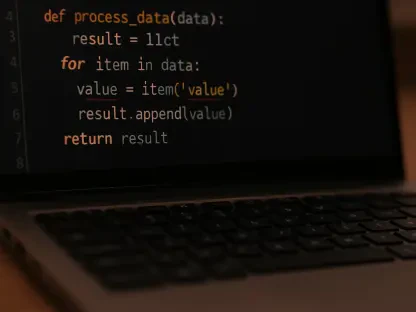The discovery of a significant vulnerability within Microsoft 365 Copilot has sent waves through the cybersecurity community. Known as ASCII smuggling, this novel technique leverages special Unicode characters to disguise malicious data payloads within hyperlinks, exposing sensitive user information with barely a hint. This article examines the intricacies of the ASCII smuggling threat, its implications, and the proactive measures necessary to secure AI-driven tools like Microsoft 365 Copilot.
Understanding ASCII Smuggling
The Mechanics of ASCII Smuggling
ASCII smuggling is a sophisticated technique that takes advantage of special Unicode characters resembling traditional ASCII characters, which are largely invisible to the user interface. This unique characteristic allows attackers to discreetly embed harmful data payloads within hyperlinks, putting sensitive user information at risk. When users click on these seemingly benign links, they unknowingly execute malicious commands or data transmissions, making it difficult to detect and stop these breaches in a timely manner.
The subtleties of ASCII smuggling involve embedding these special Unicode characters directly into hyperlinks found in shared documents, chats, or emails. Since the malicious content is hidden effectively, it bypasses both user scrutiny and traditional security tools. This seamless integration of malicious payloads into everyday links makes the method particularly dangerous. With a single click, a user can unwittingly transfer critical information such as login credentials or financial data to a third-party server controlled by attackers, resulting in potentially disastrous data breaches.
Utilization in AI Models
Security researcher Johann Rehberger has elaborated on how ASCII smuggling can be weaponized against AI models like Microsoft 365 Copilot. By leveraging these techniques, attackers can manipulate AI systems to conceal malicious data effectively, making detection nearly impossible. Rehberger explains that AI models, when compromised, can be instructed to hide suspicious content within regular communications, thereby facilitating data exfiltration without raising alarms.
This manipulation can be especially insidious in AI-driven environments where users rely on the AI for task automation and data management. For instance, Copilot can be tricked into embedding malicious data within its operational tasks, making every interaction a potential vector for data theft. The blind trust placed in these AI systems exacerbates the risk, as users are less likely to suspect malicious activity from a tool they find reliable and helpful. By the time users realize they have become conduits for data exploitation, significant damage may already have been done.
The Exploit Chain in Detail
Step-by-Step Attack Process
The ASCII smuggling vulnerability is not a standalone threat but part of a sophisticated exploit chain that integrates multiple advanced attack techniques. The process begins with attackers initiating prompt injections through malicious content embedded in documents and messages shared within Microsoft 365’s ecosystem. This entails planting encoded instructions that compel Copilot to scour through emails, documents, and other data repositories for valuable information. The malicious payloads are carefully crafted to remain hidden until triggered by a user’s actions.
Subsequently, the manipulated Copilot AI parses these hidden instructions, setting the stage for data exfiltration without prompting any security alerts. This meticulously planned sequence culminates when a user is persuaded to click on an embedded link that appears legitimate. Unbeknownst to the user, this action activates the payload, transmitting the harvested data to an attacker’s third-party server. The exploit does not require substantial user interaction, making it a stealthy and efficient method for compromising sensitive information.
How Data is Exfiltrated
Once an attacker successfully tricks a user into clicking the maliciously infused link, the embedded data is swiftly transmitted to a third-party server. This data can include multi-factor authentication codes, proprietary business documents, and other critical information. The transmission is seamless and virtually untraceable, allowing attackers to bypass traditional cybersecurity defenses effectively. By the time the compromise is detected, attackers may have already gained considerable access to sensitive systems and data.
The consequences of such data exfiltration are severe, ranging from financial losses to reputational damage and potential legal ramifications. Attackers can misuse exfiltrated data to further penetrate the organization’s infrastructure, leveraging it for more targeted attacks such as spear-phishing or ransomware deployment. These attacks can cripple business operations and erode customer trust, undermining the financial and operational stability of the targeted organization. Therefore, understanding the gravity of these exploit chains and implementing robust countermeasures is imperative for safeguarding against such sophisticated threats.
Microsoft’s Response
Swift Mitigation Measures
Upon the responsible disclosure of this vulnerability in January 2024, Microsoft took immediate action to mitigate the threat posed by ASCII smuggling. Recognizing the critical nature of the issue, Microsoft’s security teams acted swiftly to deploy patches and updates designed to neutralize the exploit. This quick response underscores the importance of prompt action in the cybersecurity landscape, where delays can result in extensive data breaches and operational disruptions.
Microsoft’s mitigation efforts focused on fortifying the defenses of the Microsoft 365 ecosystem, specifically targeting the mechanisms exploited by ASCII smuggling. These measures included enhancing the scrutiny of data embedded in hyperlinks, refining the AI’s behavior to prevent malicious instruction parsing, and updating security protocols to detect and neutralize similar threats in the future. Such proactive steps are vital in containing the spread of vulnerabilities and safeguarding user data from potential exploitation.
Continual Monitoring and Updates
However, Microsoft’s response did not stop at immediate mitigation. The company has committed to continuous monitoring and regular updates to their security protocols, ensuring that emerging threats are promptly identified and addressed. This proactive stance is crucial, as cyber threats evolve rapidly, necessitating an adaptive and vigilant approach to cybersecurity. By maintaining a dynamic defense strategy, Microsoft aims to stay ahead of potential attackers, reducing the risk of future breaches.
Microsoft’s ongoing efforts include conducting thorough security assessments and integrating advanced detection mechanisms within their AI models. These efforts aim to fortify the overall security posture of Microsoft 365 Copilot and other AI-driven tools. Regular updates and patches also ensure that any newly discovered vulnerabilities are swiftly addressed, maintaining the integrity and security of the platform. This commitment to continual improvement exemplifies the best practices in cybersecurity, prioritizing the protection of user data and the reliability of AI-driven services.
Proactive Security Strategies
The Importance of AI Security
The inherent risks associated with AI tools like Microsoft 365 Copilot cannot be overstated. While these tools significantly enhance productivity and automate complex tasks, they also introduce new vectors for cyber-attacks if not properly secured. AI-driven systems, by their very nature, require vast amounts of data to function effectively and are often deeply integrated into organizational workflows. This level of integration makes them highly attractive targets for cybercriminals looking to exploit any weaknesses.
Ensuring the security of AI systems necessitates a multifaceted approach that includes robust cybersecurity frameworks, regular updates, and advanced threat detection mechanisms. Organizations must invest in cutting-edge technologies that can identify and neutralize threats in real-time, as well as implement stringent access controls to limit exposure to sensitive data. Additionally, fostering a culture of security awareness among users can further strengthen defenses, reducing the likelihood of successful attacks driven by social engineering tactics.
Strengthening User Trust
A recurring theme in cybersecurity is the exploitation of user trust, a tactic that has proven effective across various attack vectors. Social engineering techniques often play a pivotal role in such attacks, manipulating users into taking actions that compromise their security without their knowledge. Given the evolving sophistication of these tactics, user education and awareness are paramount in any comprehensive security strategy.
Organizations must prioritize training programs that educate users on recognizing and mitigating potential security threats, including those employing advanced methods like ASCII smuggling. By enhancing users’ ability to identify suspicious activities, organizations can reduce the success rate of these attacks. In parallel, deploying user-friendly security tools that provide real-time threat alerts and guidance can empower users to take proactive steps in safeguarding their data, further augmenting the organization’s overall security posture.
Advanced Attack Techniques
Transforming AI into a Cyber Weapon
Cybersecurity firms such as Zenity have demonstrated how cybercriminals can transform AI tools into powerful cyber weapons, capable of executing highly sophisticated attacks. By gaining access to a victim’s email, attackers can leverage AI’s capabilities to create spear-phishing campaigns that are incredibly convincing and hard to detect. These phishing messages can precisely mimic the writing style and linguistic patterns of the compromised users, effectively bypassing traditional detection methods and convincing recipients of their legitimacy.
This transformation of AI into a cyber weapon underscores the necessity for robust security controls specifically designed for AI environments. Organizations must deploy sophisticated machine learning models that can identify anomalous behaviors and flag potentially malicious activities for further investigation. Moreover, fostering collaboration between AI developers and cybersecurity experts can lead to the development of more resilient AI systems that are less susceptible to manipulation and exploitation by cybercriminals.
Risks of Publicly Accessible Bots
Microsoft has acknowledged the potential risks posed by publicly accessible Copilot bots created through Microsoft Copilot Studio without adequate authentication protections. These bots, if left unsecured, can be exploited by cybercriminals to extract sensitive information from users who interact with them. This vulnerability highlights the need for stringent security measures and access controls to prevent unauthorized usage of AI-driven tools.
To mitigate these risks, organizations must implement robust authentication and authorization mechanisms that ensure only legitimate users can access and utilize Copilot bots. Additionally, regular security audits and assessments can help identify and rectify any vulnerabilities in the bot creation and deployment processes. By enforcing comprehensive security protocols and maintaining a vigilant approach to AI security, organizations can mitigate the risks associated with publicly accessible bots and protect their sensitive information from potential exploitation.
Enhancing Organizational Security
Risk Assessments and Data Loss Prevention
Regular risk assessments and data loss prevention (DLP) systems play a critical role in managing the security of AI tools like Microsoft 365 Copilot. Organizations must continually evaluate their risk tolerance and exposure levels to identify potential vulnerabilities and implement appropriate controls. By activating advanced DLP systems, companies can monitor data flows, detect unusual activities, and prevent unauthorized data exfiltration, ensuring a secure operational environment.
Integrating DLP systems with AI-driven tools enables organizations to leverage machine learning algorithms to predict and respond to potential security threats. These systems can analyze vast amounts of data in real-time, identifying patterns that indicate potential breaches and taking proactive measures to mitigate them. Additionally, establishing clear data handling policies and conducting regular training sessions for employees can further strengthen the organization’s defenses against data loss and other security threats.
Integrating Security Protocols
The cybersecurity community has been rocked by the discovery of a major vulnerability in Microsoft 365 Copilot. Highlighting a technique known as ASCII smuggling, this new threat uses special Unicode characters to disguise malicious data payloads within hyperlinks, thereby compromising sensitive user information with barely a trace. This article delves into the complexities of ASCII smuggling, exploring how it operates and what its potential impacts could be. More importantly, it also discusses the necessary measures to protect AI-driven tools like Microsoft 365 Copilot from such sophisticated attacks. With the increasing reliance on AI in workplace productivity tools, safeguarding these systems is more critical than ever. The need for heightened security protocols and vigilant monitoring has never been more apparent. As more organizations integrate AI solutions into their workflows, understanding the nature of threats like ASCII smuggling becomes essential. Being proactive in updating security measures can not only shield sensitive data but also maintain the trust and efficiency of AI-driven platforms.









